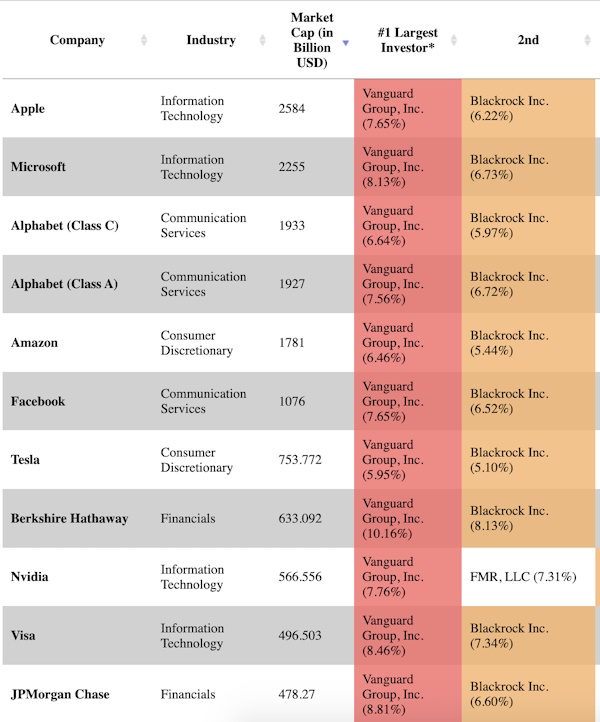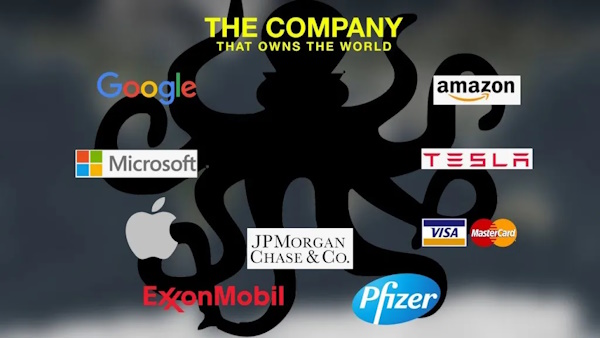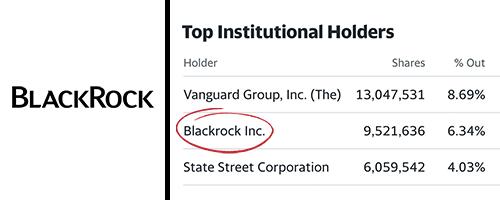The Future of Food: “We Are Witnessing a Controlled Demolition of the Food Supply Chain.”
The Future of Food: “We Are Witnessing a Controlled Demolition of the Food Supply Chain.”
by James Corbett & Broc West, The Corbett Report
June 11, 2024
We all know the problems of the modern factory farming system. But, as bad as things are, they’re about to get even worse. New technologies are coming online that threaten to upend our understanding of food altogether. Technologies that could, ultimately, begin altering the human species itself. This is The Future of Food on The Corbett Report.
Video available at Odysee, Rumble, BitChute
Transcript:
If it is true that “you are what you eat,” as the old adage has it, then what does that make us?
As consumers of heavily processed, chemically treated, GMO-infested gunk, we in the modern, developed world have solved the problem of hunger that plagued our forebears since time immemorial by handing our food sovereignty over to a handful of corporate conglomerates.
The result of this handover has been the creation of a factory farming system in which genetically engineered crops are doused in glyphosate and livestock are herded into tiny pens where they live their entire lives in fetid squalor, pumped up with antibiotics and growth hormones until they are slaughtered and shipped off to the supermarkets and fast food chains.
There are plenty of documentaries and exposés detailing the dangers of this industrial farming system that we find ourselves beholden to. Any number of activists ringing the alarm about these problems. Numerous campaigns and marches organized to raise awareness about these issues.
Yet still, nation after nation gets fatter and sicker as traditional diets based on fresh produce sourced from local farmers are displaced by the fast food pink slime sourced from the industrial farms of the Big Food oligopoly.
But, as bad as things may be, they’re about to get even worse. As crisis after crisis disrupts the food supply, the “solution” to these problems has already been prepared.
New technologies are coming online that threaten to upend our understanding of food altogether. Technologies that could, ultimately, begin altering the human species itself.
This is your guide to The Future of Food. You are watching The Corbett Report.
Food As A Weapon
So what is food, anyway?
To a normal human being whose head is screwed on straight, that sounds like a dumb question. Food is fuel for the body, obviously.
Oh, sure, we could get fancy about it. Scientists might talk about the caloric content of different foods, or measure their macronutrient levels. Sociologists might point to food as the basis of human community, drawing people together into families, tribes and communities to break bread and engage in social relations. Theologians may even discuss the transubstantiation of bread and wine and the communion with God that such sacred acts of consumption make possible. . . .
. . . But then there are the psychopathic would-be world controllers. These Machiavellian schemers would define food in a very different manner. To them, food is a very different thing altogether.
To those seeking to rule over nations, food is a weapon.
For millennia, attacking armies have known that a city can be conquered by blockading it. Eventually, the besieged city’s inhabitants will run out of food and will either starve to death or surrender.
The English knew that food was a powerful tool of control. They created the conditions that led to the Irish Potato Famine and then stood idly by as millions died or were displaced, because—in the memorable words of Charles Trevelyan, who was in charge of the British government’s response—”the judgement of God sent the calamity to teach the Irish a lesson, that calamity must not be too much mitigated.” But the Irish were neither the first nor the last to feel the brunt of the British Empire’s indifference to their hunger; just ask the Bengals about their own famine.
The 20th-century example of this “food as a weapon” mindset that immediately springs to mind is the Holodomor, a brazen act of genocide perpetrated by Josef Stalin’s Soviets against the Ukrainians in order to force through his campaign to collectivize agriculture in the USSR and to silence the agrarian peasants who were rebelling against that policy. The ensuing famine killed millions of Ukrainians.
But the Holodomor is certainly not the only time that food was weaponized in the previous century. Who can forget arch-globalist Henry Kissinger’s National Security Study Memorandum 200: Implications of Worldwide Population Growth for U.S. Security and Overseas Interests? This now-infamous document—drafted by Kissinger in December of 1974 and adopted as official policy by President Ford in 1975—argues that since “[g]rowing populations will have a serious impact on the need for food,” food aid to the developing world may need to be tied to mandatory sterilization programs or population reduction quotas. Even the coolly calculating Kissinger was forced to concede that such a scheme would turn food into “an instrument of national power.”
But that was then. This is now! Surely this “food as a weapon” idea has been retired, hasn’t it?
Lest there be any doubt that food is still being weaponized against us in the 21st century, we only have to turn to the latest news headlines to see that this idea is far from a relic of the past.
From the disruptions to the global food supply caused by the COVID lockdowns and restrictions to the decimation of the Ukrainian wheat harvest caused by the Russian invasion in 2022, the shocks to the global food supply chain have contributed to a doubling in the number of people facing acute food insecurity in the last four years.
Given this vivid demonstration of just how fragile the global food supply is and just how much economic and societal chaos can result from any shock to this system, it would be unthinkable that governments would now be deliberately attempting to undermine that supply chain further, wouldn’t it?
Well, think again. From the Netherlands to Ireland to Poland to Italy to Canada to Argentina to Sri Lanka, governments are cracking down on farmers, forcing them to cull herds, lower production, dump milk and comply with onerous new operating restrictions in the name of reducing pollution.
These governments are not stupid. Like the British, the Soviets, the Americans and other repressive regimes throughout history, they know that these measures, if played out to their conclusion, will result in widespread hunger and unrest. In fact, we’ve already seen massive protests against these restrictions in numerous countries, from Germany to Italy to Poland to Spain to Panama to Argentina to Canada. And that’s to say nothing of the mass Dutch farmer protests in recent years and Sri Lankans running their president out of the country when it became obvious that the government’s green policies and farming restrictions had contributed to the collapse of that nation’s economy.
And now, we find that the food supply itself is under attack.
ANCHOR: 40,000 pounds of food meant to feed people in a food desert near Maricopa, south of the valley, is completely gone.
And tonight, investigators are still trying to figure out what caused the fire.
SOURCE: Fire at Maricopa Food Pantry destroys 40,000 pounds of food
ANCHOR: Breaking news out of Pasco County: crews battling a huge fire at a chicken farm. It’s all happening on Cal Main Foods along Simpson Farm Lane in Dade City.
SOURCE: Dade City poultry farm fire likely killed 250,000 chickens
ANCHOR: Firefighters trying to figure out what sparked a fire at a food processing plant on the west side. It happened around 9.30 last night on Merida Street near South Zarzamora.
SOURCE: West Side food processing plant left with smoke damage after fire, SAFD says
ANCHOR: Breaking news in eastern Oregon, where crews are battling a major fire at a potato chip processing plant. Air 12 flew over the scene at Shearer’s foods on highway 207 in Hermiston.
SOURCE: At least two people injured in explosion at Hermiston food plant
ANCHOR: Crews were on the scene of a massive fire at an egg farm earlier this afternoon. The fire broke out at the Hillendale Farms location on Schwarz Road. The Salvation Army says around 100,000 chickens may have died in that fire.
SOURCE: VIDEO: 100,000 chickens die in Bozrah egg farm fire
A series of mysterious fires, explosions, incidents of arson and even cyberattacks on food processing facilities across the United States in recent years has prompted law enforcement agencies to warn of a coordinated attack on the food supply.
In April 2022, the FBI even issued an official notice to private industry warning that “ransomware attacks against the entire farm-to-table spectrum of the FA [Food and Agriculture] sector occur on a regular basis” and noting that such attacks are “disrupting operations, causing financial loss, and negatively impacting the food supply chain.”
This mysterious attack has taken place at the same time as a massive disruption of the global food supply has left the world one crisis away from disaster. With nitrogen fertilizer shortages fueling food inflation even as governments around the world crack down on their farmers’ use of fertilizers and farming inputs, and with war, drought and trade disruptions also playing havoc on food production, the global farm-to-fork system’s ability to feed the world’s population is coming into question.
Organic farmers and local agriculture advocates have been warning about the precarious nature of the global just-in-time supply chain and its lack of resilience for decades. But one group didn’t just warn about the current crisis, they predicted it in surprising detail.
In November of 2015—as you can learn from an official press release on the Cargill website—”65 international policymakers, academics, business and thought leaders gathered at the World Wildlife Fund’s headquarters in Washington DC to game out how the world would respond to a future food crisis.” Over the course of two days, the participants in this “Food Chain Reaction” crisis simulation role-played a response to a number of converging and overlapping catastrophes in the 2020s, including “two major food crises, with prices approaching 400 percent of the long term average; a raft of climate-related extreme weather events; governments toppling in Pakistan and Ukraine; and famine and refugee crises in Bangladesh, Myanmar, Chad and Sudan.” The game—which, we are assured, “was built over the course of months, with maximal realism in mind”—went on to envision some very specific scenarios that bare an eery resemblance to current-day reality, including “a steep price spike with looming global food shortages in 2022” that prompted the EU players to impose a tax on meat.
Lest the meaning of this exercise be lost on the general public, the World Wildlife Fund went on to spell it out in their after-action report on the simulation: “Only by stopping agricultural expansion, augmenting agricultural production, increasing resource-use efficiency, and reducing food waste, can we provide the food and nourishment we need, while ensuring we are conserving nature for future generations.” Accordingly, this “game” ended with the imposition of a global carbon tax.
In February 2024, the European Union ran its own food crisis simulation. The exercise—which brought 60 EU and government officials together for a 2-day conference in Brussels—envisioned a cascading series of food emergencies unfolding over the next two years, from harvest failures and fertilizer shortages to popular uprisings and unrest. The war game ended, predictably enough, with the government bureaucrats calling for more centralization of food reserves and stockpiles in the name of biosecurity and concluding that “diets need to shift toward healthier options and away from meat.”
This EU crisis simulation and the “Food Chain Reaction” exercise, combined with a series of government and NGO-sponsored awareness campaigns related to food security—including the Rockefeller Foundation’s “Reset The Table” report calling for further consolidation of the global food supply and the Chinese government’s “Clean Your Plate Campaign,” which aims to bring technocratic management of the economy into every citizens’ dining room—throw the current round of mysterious and unexplained attacks on food processors and farmers into stark relief. Together, these campaigns and exercises suggest that the current food crisis is not a naturally occurring event, but a deliberately engineered phenomenon.
But if this food crisis is being knowingly engineered, the question is why? What could governments gain by creating food shortages for their own people?
The answer is simple. We are witnessing a controlled demolition of the food supply chain, one that is intended to result in the destruction of the current industrial farming system as we know it. But this changeover is not intended to return us to truly sustainable farming practices, with local, organic farmers producing crops in accordance with age-old agricultural wisdom. Far from it.
As it turns out, the “solution” to this food crisis, the one being proffered by the billionaires of the corporate-pharmaceutical-medical-industrial-philanthrocapital-military complex, is being engineered in laboratories and sold to the public via a bought-and-paid-for mainstream media.
One thing is for certain: the future of food will look very different from anything that we have seen in human history.
The Future of (Weaponized) Food
Now, anyone who has been paying attention in recent years will already know the direction that the food industry is heading.
Yes, by now we all know the “Eat Ze Bugs” agenda being pushed by Klaus Schwaub and his Davos minions. I guarantee that wherever you are, in whatever corner of the world you are reading this editorial, you will have seen (or could easily find) a local news story about high school students “spontaneously requesting” cricket powder dumplings in their school lunch or a puff piece about how valiant scientists are working to save the world with worm burgers.
And we all know about the GMO problem: genetically modified organisms making their way into our food supply. We know about the multiple health studies that have proven time and time again the deleterious health effects of GMO consumption. We know about the insane lengths that the GMO giants have gone to to suppress bad news about their products and the insane lengths that the press has gone to to assist them in this cover-up. And we know about the additional harms that this technology causes, ruining farmer’s lives, contaminating the genome of the planet and causing associated products like glyphosate to further contaminate the food supply and further endanger our health.
But do we know about the next evolution in culinary technology? Now that scientists are playing around with the fundamental building blocks of life, reengineering organisms at the cellular level, an entire field of biotechnology is opening up that is threatening to fundamentally transform what we think of as food itself.
Moving beyond the simple insertion of foreign genes into an organism, scientists are now working on creating foodstuffs from designer microbes, engineering organisms into “bioreactors” that can be used to grow proteins and other materials for food production, growing meat-like products from cells in the laboratory and dozens of other zany ideas.
NARRATOR: The meat of the future will likely be lab-grown. Compared to our conventional methods of putting meat on the table, lab-grown meat—which debuted in 2013—doesn’t involve slaughtering of animals, nor does it require as many environmental resources.
SOURCE: The Meat of the Future: How Lab-Grown Meat Is Made
HOST: I’m about to be one of the first people on Earth to eat real chicken grown entirely in a lab. That’s right, we’re talking the most futuristic nuggets ever.
SOURCE: Lab-Grown Meat is Here… and I Taste-Tested It!
AMNA NAWAZ: Nearly 90 percent of Americans eat meat as a part of their diet. But earlier this year the Agriculture Department approved the production of what’s known as cultivated meat. That is, chicken grown in a lab.
SOURCE: How ‘lab-grown’ meat is made and will people accept it?
NARRATOR: This machine is 3D printing steak. The goal is to create a piece of meat without killing a cow. And this Israeli startup is one of the dozens of companies racing to perfect the process.
SIMON FRIED: It turns out that cows aren’t necessarily the most efficient way of making beef.
SOURCE: Can Lab-Grown Steak be the Future of Meat? | Big Business | Business Insider
After a near-decade-long PR campaign, you’ve probably heard of Impossible Foods and Beyond Meat, companies that employ the latest techniques in chemical engineering to create plant-based meat substitutes. But there are many more technologies around the corner that threaten to transform our food supply in even more bewildering ways.
Scientists are bioengineering spores that can be inserted into crops and livestock, allowing companies to identify and track food products all the way through the food system, from farm to factory to fork.
VISHAAL BUYAN: We use microbes as tracking devices. So what we do is we convert data digital data into strands of DNA. We insert that little bit of DNA into a microorganism. A probiotic microorganism, to be honest. And then we can sort of apply that organism and sort of “hitch a ride” on any food or agricultural product or really anything through the supply chain. And the reason we use a microbe to do it is because we engineer it to go into a spore, so that dormant state allows it to be impervious to high temperatures and UV light sort of protect that DNA barcode through transit.
SOURCE: Eating Bioengineered Spores
DARPA is doling out multi-million-dollar contracts for researchers to find ways “to turn military plastic waste into protein powder” for human consumption.
STEVE TECHTMAN: What we’re trying to do is to use microbes to take plastic and other inedible plant material and turn that into something that’s nutritious.
REPORTER: The idea is to turn components of plastic into protein and other nutrients like fats and sugars. If that sounds kind of gross to you, well . . .
TECHTMAN: I don’t want to eat plastic either. What we’re trying to do is to take that plastic and turn it into something completely different.
SOURCE: Turning Plastic Into Protein?
A company called Amai Proteins is using genetically engineered microbes to create peptides that taste like sugar but are digested like proteins, a process that, the company brags, allow their product to be legally sold as non-GMO even though, as they openly admit, these microbes are technically genetically engineered.
ILAN SAMISH: Then, we grow the protein. We biomanufacture it using yeast, just like you do in a brewery. We harvest the protein to get 100% pure protein. And last, our ProTaste food technology incorporates the protein to replace up to 70% of the sugar without compromising taste.
SOURCE: Sweet Protein | BBC StoryWorks
And then there are companies like Indigo Ag, a Boston-based agricultural technology company, and tech companies like EY Global and Microsoft, who are ushering in The New Normal Of Agriculture by—as their thinly-disguised corporate PR masquerading as “investment news” likes to boast—”utilizing advanced AI and machine learning techniques to create a revolutionary agronomics platform that boosts farmland sustainability and productivity through next-gen microbiome treatments, digital regenerative content, time-series satellite imagery, advanced crop monitoring and data analysis, and grain quality testing.”
NARRATOR: What if you could predict the best crops to grow using the power of data, recognize crop disease or pests faster, connect with vendors seamlessly, doing all this knowing you control your own data? With data captured from each field and connected to predictive analysis, farmers have an unprecedented view of their crops.
SOURCE: Innovating for Agribusiness – EY and Microsoft
Of course, these technologies will be sold to the public as a way to remarkably improve upon the boring old “food” that humanity has relied on for untold millennia. This isn’t food after all, this is Food 2.0!
Molecular gastronomy will allow for the creation of all sorts of zany and unimaginable dishes, from spherified juices to deep-fried hollandaise to lollipopified octopus!
In the nutrigenomical kitchen of the future, the AI systems that plan our meals and assemble our food will be able to precisely tailor our diet to our individual genome, calculating the exact portions of foodstuffs (or lab-grown food substitutes) we need to consume to meet our desired health goals!
And who needs a chef? In the future, we’ll bring the Star Trekkian idea of the replicator into reality by 3D printing all our food right in our own kitchen!
NARRATOR: You’re hungry. But instead of whipping up a meal, all you have to do is enter your menu choices into a computer and your dinner appears before you. So magical!
It may seem like science fiction, but it isn’t. Well, not completely. The future is now, my friends!
Is 3D printed food in your future?
SOURCE: Is 3D Printed Food the Future?
The propaganda that is being rolled out to sell the public on this transformation of our food supply sounds like the sales pitch of a used car salesman. This should not be surprising. For those who know the players who are pushing this “Food 2.0” agenda and their real intentions, it is obvious that the enormous and unbelievably hubristic effort to replace natural food with laboratory-made food substitutes is not about helping the poor and starving to achieve food security, but rather to deprive them of the earth’s natural abundance.
The end result will be a population dependent on the laboratory-produced food substitutes produced by a handful of corporations and a population at the mercy of the scientists these corporations employ. These molecular magicians will, after all, be able to insert all manner of exotic agents into the food supply at any time.
But to really understand where this agenda is heading and how quickly we are likely to get there if it is not opposed, we need look no further than the story of Future Fields. This company and its product has managed to combine the Unholy Trinity of fake food: GMOs, bugs and biotech.
MATT ANDERSON-BARON: So, today I’m here to talk about the humble fruit fly and how one day it could save your life—and perhaps all of humanity! So, science has given us countless medical miracles. You know: pandemic-stopping vaccines, life-saving therapies. But one of the most impactful things that it’s given us and given modern medicine is genetic engineering of biological systems.
SOURCE: How can a fruit fly save your life? Future Fields at Collision 2023
Future Fields, a Canadian biotech company, has notified the Canadian government of its intention to commercialize “EntoEngine,” a type of fruit fly that “has been genetically engineered to express a growth factor isolated from cows.” This growth factor, it turns out, is an important component of the lab-grown meat recipe, which has so far required the use of “fetal bovine serum” (FBS)—a substance extracted from unborn cattle—to grow the meat cells. But now that the “EntoEngine” has been created, Future Fields is excited to use these flying “bioreactors” to produce the growth factor faster and more cheaply than before.
Yes, from cricket powder dumplings and bug burgers to GMOs and glyphosate to bioreactors and designer microbes to nutrigenomics and 3D printed material, this is the future of food if the mad scientists get their way.
But who is funding these mad scientists? Where do they get their support? And what drives these shadowy billionaires and their non-profit organizations in their quest to reengineer the world’s food supply?
The Rockefeller Foundation
The Rockefeller family and their namesake foundation are in many ways the progenitors and the architects of the Great Food Reset. From the beginning of the so-called “Green Revolution” to the so-called “Gene Revolution,” the Rockefellers have been there, helping to move things along with their “philanthropic” donations.
In the 1940s, they founded the Mexican Agricultural Program in Mexico and the International Basic Economy Corporation in Brazil, both of which have been criticized for hooking farmers on expensive machinery and Rockefeller-supplied petroleum products. This formed the basis of the “agribusiness” concept that emerged, predictably enough, from the Harvard Business School out of research conducted by Wassily Leontief under a Rockefeller Foundation grant.
The Rockefeller’s agribusiness model arguably did more to change the course of human civilization in the 20th century than anything other than war. It transformed farming and traditional agriculture into the business-led, input-intensive industrial enterprise that it is today, and led to the creation of the global food supply chain.
But the Rockefellers’ influence did not end in the 21st century.
In 2006, The Rockefeller Foundation co-founded the Alliance for a Green Revolution in Africa, whose stated goal of “elevat[ing] the single African voice” on the world stage is belied by the fact that over 200 organizations have come together to denounce the alliance and its activities, claiming that the group has not only “unequivocally failed in its mission” but has actuall y “harmed broader efforts to support African farmers.”
And in 2020 the Rockefeller Foundation released a report entitled “Reset the Table: Meeting the Moment to Transform the U.S. Food System” calling for a further centralization of control over the food supply, including “a new, integrated nutrition security system.”
Bill Gates
Having explicitly cited The Rockefeller Foundation as one of its main inspirations, it’s no surprise that the Bill & Melinda Gates Foundation has emerged to become one of the most important players in the Great Food Reset in recent years.
Gates was an important early backer of “Impossible Burger” and its lab-grown synthetic biology food substitute. He also provided capital to Impossible rival Beyond Meat . . . until Beyond’s stock began to crumble. Miraculously, the Bill & Melinda Gates Foundation Trust was able to divest itself of its Beyond Meat stock right before the shares tanked in 2019.
And, as PleaseStopTheRide.com has pointed out, Gates is also investing millions into “hacking your microbiome” to reengineer humans’ gut bacteria.
Ominously, Bill Gates has also recently become the biggest owner of US farmland, a move that allows him unprecedented control over the future of farming in America.
USAID
Created in 1961 by executive order, USAID is a US government agency that has participated in subterfuge and counterinsurgency operations in Venezuela, Cuba, Ukraine and numerous other countries under the guise of providing humanitarian assistance and, of course, food aid.
Last year, USAID, in conjunction with “Feed the Future” (the U.S. government’s global hunger and food security initiative), released a working paper titled “Systemic Solutions for Climate Change Adaptation and Mitigation.” The paper argues that:
. . . a perfect storm of circumstances in which supply chain issues, regional agricultural and nutrition challenges, the ongoing effects of the COVID-19 pandemic, and regional conflict have combined to form a looming food security crisis.
Their proposal for addressing this (generated) crisis includes:
- linking “carbon markets” to “regenerative agriculture” in a move that continues the financialization of nature;
- using ESG scores as a way to pressure companies into acquiescing to the nebulous and ever-changing demands of the Food Reset agenda;
- and, of course, “the promotion of insects as sustainable sources of proteins.”
Throughout the document, USAID’s “leverage” over developing countries is referenced no less than 125 times. Given the Kissingerian food-as-a-weapon mentality that is the very basis of USAID and its mission, the document perfectly represents the kind of Rockefeller-inspired, Gates-funded, USAID-promoted, agribusiness-based neocolonialism that people in Africa and elsewhere have been warning about for decades.
This list of Great Food Reset culprits is of course incomplete. I haven’t even mentioned the participants in the “Food Chain Reaction Game” or the “nitrogen reduction” schemes being pushed by national governments around the world or the Global Crop Diversity Trust and its ominous Svalbard seed vault or any of a million other relevant players and factors in this grand transformation.
But from this (admittedly incomplete) exploration we can begin to make a list of the types of players that are behind this push to “transform the global food supply” and better understand their methods and motivation. And, armed with that knowledge, we can start formulating our own plans for counteracting this agenda.
THE PUSHBACK
Now, if there is any good news to be had in the sad saga of future (fake) food, it’s that the people are waking up to the Great Food Reset agenda and they are not happy about it.
For a trivial example of the pushback against the fake food agenda and the oligarchs stewarding over it, witness Bill Gates’ recent “AMA” (ask me anything) thread on reddit, where one heavily upvoted question put the issue to America’s largest farmland owner directly:
Why are you buying up so much farmland, do you think this is a problem with billionaire wealth and how much you can disproportionally acquire? [sic]
Gates’ answer—employing the fact checkers’ ACKSHUALLY! by pointing out that he “own[s] less than 1/4000 of the farmland in the US [sic]” and that his only interest in farms is “to make them more productive and create more jobs”—is to be expected from a man who has spent billions on PR and propaganda in recent decades to transform his public image from that a reviled tech monopolist to that of a revered billionaire philanthropist.
The response to that answer, however—observing that 1/4,000th of US farmland is still an incredibly large amount of land and that Gates did not explain how consolidation of farmland in fewer hands will transform the agricultural sector—shows that the public is not buying Gates’ PR wholesale anymore.
A less trivial example of the pushback against Gates and his ilk is to be found in the “Open Letter to Bill Gates on Food, Farming, and Africa” published last November and signed by no less than 50 organizations dedicated to food sovereignty, including the Community Alliance for Global Justice/AGRA Watch and the Alliance for Food Sovereignty in Africa. The letter derides Gates’ role in “creating the very problem” of global food shortages that he is ostensibly “fixing,” accusing him of pushing ineffective (but profitable) technocratic solutions instead of simpler, less expensive agricultural solutions:
There are already many tangible, ongoing proposals and projects that work to boost productivity and food security—from biofertilizer and biopesticide manufacturing facilities, to agroecological farmer training programs, to experimentation with new water and soil management techniques, low-input farming systems, and pest-deterring plant species. What you are doing here is gaslighting—presenting practical, ongoing, farmer-led solutions as somehow fanciful or ridiculous, while presenting your own preferred approaches as pragmatic. Yet it is your preferred high-tech solutions, including genetic engineering, new breeding technologies, and now digital agriculture, that have in fact consistently failed to reduce hunger or increase food access as promised.
The pushback against the transformation of the food supply is not limited to Gates and his eponymous foundation’s efforts, however.
Resistance against GMO foods, for instance, is massive. In fact, the more the biotech billionaires try to shove their genetically modified monstrosities on vast swaths of the human population, the more the public is rising up to reject them. In recent months alone we have seen people rebelling against GMOs in Turkey, Kenya, Nigeria, Mexico, Pakistan and Indonesia.
All of these protests against the Great Food Reset are hopeful signs. They show that the public are not simply going to swallow anything that is put on their plate.
But even more important than these examples of protest and pushback are the things that we can do to take the Future of Food away from the agribusiness conspirators and their bought-and-paid-for politicians and put it back in the hands of the people.
It involves getting our hands dirty and getting to work . . . but that’s the way it’s always been. And the alternative to this, this working of the land, is, as we have seen, no alternative at all.
And in the end, the future of food is ours to decide. Happy planting!
























